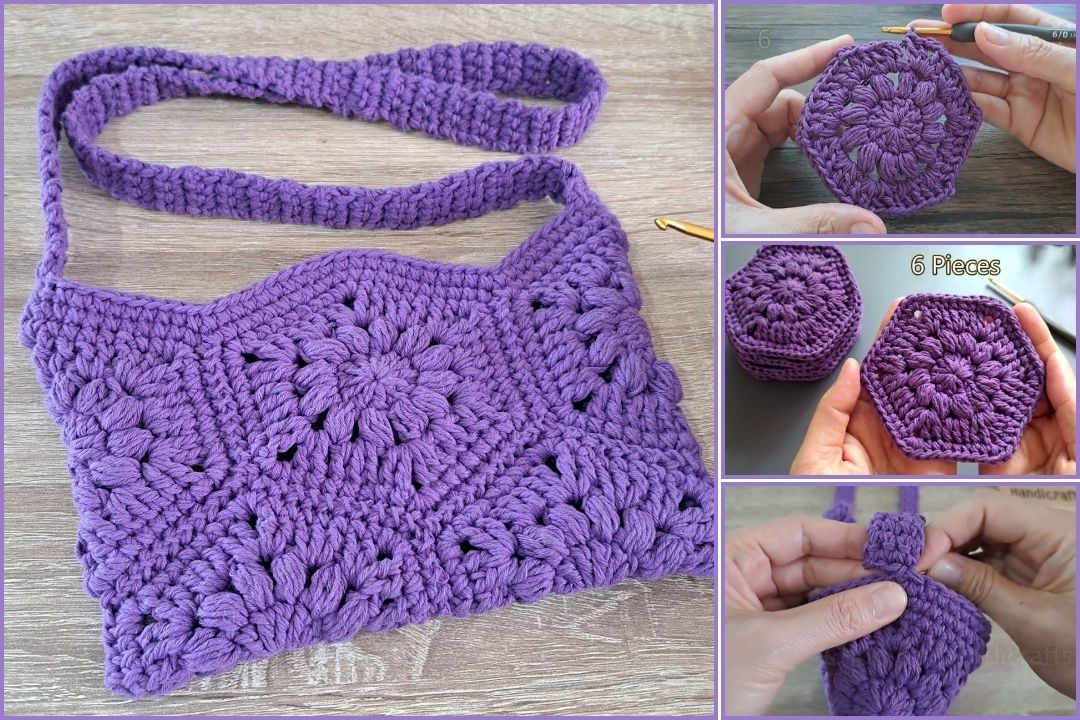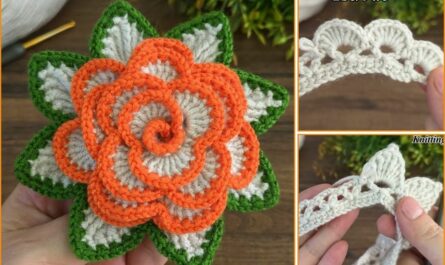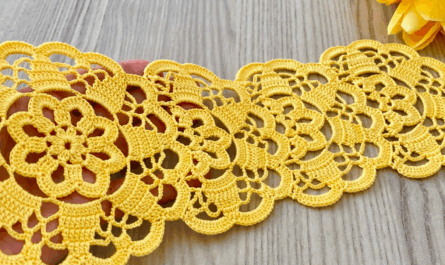Crafting a crochet granny hexagon bag is a fantastic project that combines the charm of traditional granny squares with a unique geometric shape, resulting in a stylish and practical accessory! It’s a bit more involved than a simple square tote, but the process is very rewarding and the finished bag is truly eye-catching.
For a durable and beautiful bag, especially in Phnom Penh’s climate, 100% cotton yarn or a cotton blend is highly recommended. It offers excellent stitch definition, holds its shape well, and is easy to maintain.
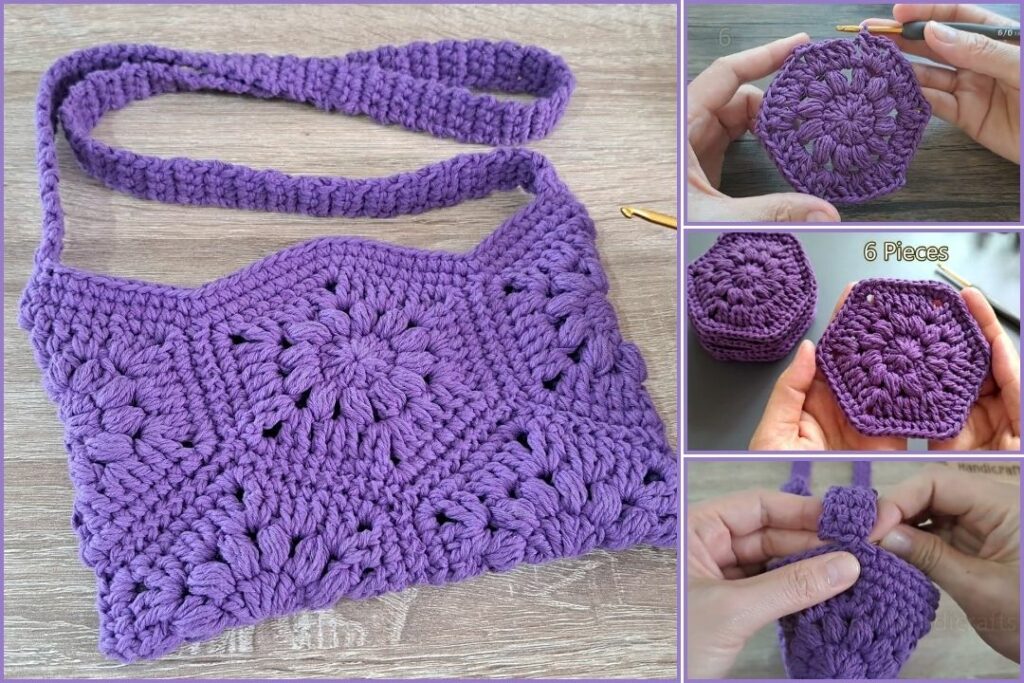
How to Crochet a Beautiful Granny Hexagon Bag
This tutorial will guide you through creating a charming granny hexagon bag. We’ll focus on a design that uses a central granny hexagon for the base and then builds the sides upwards with more granny hexagon motifs or continuous rounds, finally adding a handle.
1. Essential Materials You’ll Need
- Yarn:
- Fiber: 100% Cotton or a Cotton Blend (e.g., 80% Cotton / 20% Acrylic). These are durable, resist stretching, and provide great stitch definition for the granny motif.
- Weight: Worsted Weight (Aran / Medium / 4) is ideal. It works up at a good pace and creates a sturdy fabric.
- Colors: This is where you can get creative! Choose 2-4 colors for your granny hexagons. You could use one color for the center and alternate for the outer rounds, or change colors every round for a vibrant effect.
- Quantity: For a medium-sized bag (approx. 10-12 inches tall, 12-14 inches wide), you’ll need about 500-700 yards (450-640 meters) total, distributed among your chosen colors.
- Crochet Hook: A 4.0mm (US G/6) or 4.5mm (US 7) hook. Aim for a tension that creates a fabric firm enough to hold the bag’s shape without being too stiff.
- Scissors: For cutting yarn.
- Yarn Needle (Tapestry Needle): Essential for weaving in ends and seaming your hexagons together.
- Stitch Markers (Optional but Recommended): Helpful for marking corners or the beginning of rounds.
- Optional: Fabric lining (for extra durability and to prevent items from slipping through stitches), magnetic snap closure, or a button for securing the bag.

2. Basic Crochet Stitches You’ll Use
This project relies on a few fundamental stitches:
- Chain (ch): To begin your work and create chain spaces.
- Slip Stitch (sl st): Used for joining rounds.
- Double Crochet (dc): The main stitch that forms the “granny” clusters.
- Magic Ring (MR): (Also known as Magic Circle). The best way to start the center of your hexagon for a tight hole-free start.
Part 1: Crocheting the Granny Hexagon Motif
The core of this bag is the granny hexagon. You’ll make several of these.
Abbreviations (US Crochet Terms):
- ch: chain
- sl st: slip stitch
- dc: double crochet
- st(s): stitch(es)
- sp: space
- MR: magic ring
Instructions for One Granny Hexagon:
- Start (Color 1): Create a Magic Ring (MR).
- Rnd 1: Ch 3 (counts as 1 dc). Work 11 dc into MR. Join with a sl st to the top of the starting Ch 3. Pull MR tight. (12 dc)
- Self-correction: For a cleaner granny hexagon, it’s better to start with clusters in the first round.
Revised Rnd 1 (For better granny hexagon structure):
- Start (Color 1): Create a Magic Ring (MR).
- Rnd 1: Ch 3 (counts as 1 dc). Work 2 dc into MR. *Ch 2, 3 dc into MR*. Repeat from * to * 4 more times. Ch 2. Join with a sl st to the top of the starting Ch 3. (6 clusters of 3 dc, 6 ch-2 spaces)
- This directly sets up your 6 corners.
Continuing the Hexagon (Change colors at the end of each round for a striped look, or use a single color):
- Rnd 2: Sl st into the first ch-2 sp. Ch 3 (counts as 1 dc). Work (2 dc, ch 2, 3 dc) into the same ch-2 sp (this is your first corner).
- *Ch 1, skip 3 dc. Work (3 dc, ch 2, 3 dc) into the next ch-2 sp (this is your next corner).*
- Repeat from * to * 4 more times. Ch 1, skip 3 dc. Join with a sl st to the top of the starting Ch 3. (12 clusters of 3 dc, 6 ch-2 sps, 6 ch-1 sps)
- Change to Color 2 on the last sl st if desired.
- Rnd 3: Sl st into the first ch-2 sp. Ch 3 (counts as 1 dc). Work (2 dc, ch 2, 3 dc) into the same ch-2 sp.
- *Ch 1, 3 dc into the next ch-1 sp. Ch 1, skip 3 dc. Work (3 dc, ch 2, 3 dc) into the next ch-2 sp.*
- Repeat from * to * 4 more times. Ch 1, 3 dc into the next ch-1 sp. Ch 1. Join with a sl st to the top of the starting Ch 3. (18 clusters of 3 dc, 6 ch-2 sps, 12 ch-1 sps)
- Change to Color 3 on the last sl st if desired.
- Rnd 4 and onwards: Continue the pattern, always working (3 dc, ch 2, 3 dc) into each corner ch-2 sp, and (3 dc) into each side ch-1 sp, separated by Ch 1.
- For a typical tote bag, you’ll want your hexagons to be about 6-8 inches across. This might mean 4-6 rounds for each hexagon, depending on your yarn and hook.
Fasten Off: Once your hexagon reaches the desired size, fasten off your yarn, leaving a long tail (at least 12-18 inches / 30-45 cm) for seaming.

Part 2: Planning Your Bag Layout & Number of Hexagons
For a simple tote bag, you’ll need at least 4 hexagons:
- 1 Hexagon for the Base: This will be laid flat.
- 3 Hexagons for the Sides: These will stand up to form the bag’s walls.
- For a larger bag, you could use more hexagons for the base (e.g., 2 or 3 joined together) and then more for the sides (e.g., 4 or 5).
Example for a Basic Tote (using 4 hexagons):
Imagine your hexagons laid out like this:
SIDE 1
/ \
BASE -------- SIDE 2
\ /
SIDE 3
You’ll join the edges of the side hexagons to the edges of the base hexagon, and then join the side hexagons to each other.
Part 3: Assembling Your Hexagons
This is where your bag takes shape!
- Weave in All Initial Ends: Before seaming, weave in all the starting tails from your Magic Rings and any tails from color changes within each hexagon. This makes seaming much neater.
- Seaming Technique: The easiest and neatest way to seam granny squares/hexagons is often with a slip stitch join or a single crochet join (creates a slight ridge), or by using a yarn needle and whip stitch or mattress stitch (creates a flatter, almost invisible seam). For a bag, a single crochet join or whip stitch is often preferred for durability.
- Whip Stitch (Yarn Needle): Lay two hexagons flat with their wrong sides facing each other (or right sides facing each other if you want the seam on the outside). Thread your yarn needle with a long tail. Pass the needle through both loops of the corresponding stitches on each hexagon, from one edge to the other, creating a clean, tight seam.
- Joining the Base and Sides:
- Take your Base Hexagon.
- Take one Side Hexagon 1. Place one edge of Side Hexagon 1 against one edge of the Base Hexagon. Seam them together securely.
- Repeat this with Side Hexagon 2 and Side Hexagon 3, attaching them to adjacent edges of the Base Hexagon.
- You should now have a base with three “walls” standing up.
- Joining the Side Walls:
- Now, seam the adjacent edges of Side Hexagon 1 and Side Hexagon 2 together. This forms one corner of your bag.
- Repeat to seam the adjacent edges of Side Hexagon 2 and Side Hexagon 3 together. This forms the other corner.
- You will now have a bag shape with three sides, and the top open.

Part 4: Shaping the Top Edge & Adding the Handles
You have a few options here:
Option A: Simple Integrated Handles (Recommended for beginners)
- Top Edge Finishing: With your chosen top edge color (could be one of your hexagon colors or a new one), join yarn with a sl st to any corner ch-2 sp at the top opening of your bag.
- Rnd 1 (Top Edge Prep): Ch 1 (does not count as st). Work 1 sc into each dc and 1 sc into each ch-1 sp around the entire top opening of the bag. When you reach a ch-2 sp at a corner, work 3 sc into it to turn the corner neatly. Join with a sl st to the first sc. (Count your stitches!)
- Rnd 2 (Handle Creation): Ch 1. Sc in the first few stitches (e.g., 5-8 stitches, adjust to center your handle).
- Ch 40-50 (adjust chain length for your desired handle drop – test it out!).
- Sk the next 10-15 stitches (this is your handle opening).
- Sc across the next section of stitches (this is the top middle of the bag).
- Ch 40-50 (second handle).
- Sk the next 10-15 stitches.
- Sc in the remaining stitches. Join with sl st.
- Rnd 3 (Handle Reinforcement): Ch 1. Work 1 sc in each sc around the bag opening. When you reach a chain-loop handle, work sc stitches evenly into the chain loop (e.g., 1 sc per chain). Continue working sc stitches on the bag body and the second handle. Join with sl st.
- Repeat Rnd 3 one or two more times for sturdier handles.
- Fasten Off and weave in all ends securely.
Option B: Separate Strap Handles (More versatile)
- Top Edge Finishing: Work 2-3 rounds of sc stitches (Ch 1, 1 sc in each st around, join with sl st) around the entire top opening of your bag. Fasten off and weave in ends. This creates a neat top edge.
- Crochet Separate Straps:
- Strap: Ch 6 (adjust for desired strap width).
- Row 1: Sc in 2nd ch from hook and across. (5 sc)
- Rows 2-X: Ch 1, turn. Sc across. Repeat until strap is your desired length (e.g., 20-30 inches / 50-75 cm).
- Make two identical straps. Fasten off, leaving long tails for sewing.
- Attach Straps: Using your yarn needle, securely sew the ends of the straps to the inside of the bag’s top opening, symmetrical on opposite sides. Stitch multiple times for durability.

5. Finishing Your Bag
- Weave in ALL Remaining Ends: This is the most critical step for a professional-looking and durable bag. Take your time to weave in all yarn tails from color changes and seams securely into the fabric on the inside of your bag. No one wants a bag that unravels!
- Blocking (Recommended): While cotton bags hold their shape reasonably well, blocking can truly elevate your finished product.
- Gently wet your entire bag.
- Carefully squeeze out excess water (do not wring!).
- Stuff the bag with towels or newspaper to help it hold its shape. Lay it flat or stand it upright (if it can).
- Allow it to air dry completely. Blocking will help even out your stitches and make your bag look perfectly shaped.
- Optional Lining: For added durability, structure, and to prevent small items from slipping through the granny stitches, you can sew a fabric lining into your crochet bag.
- Optional Closure: Add a magnetic snap closure or a button and loop to the inside of the bag for security.
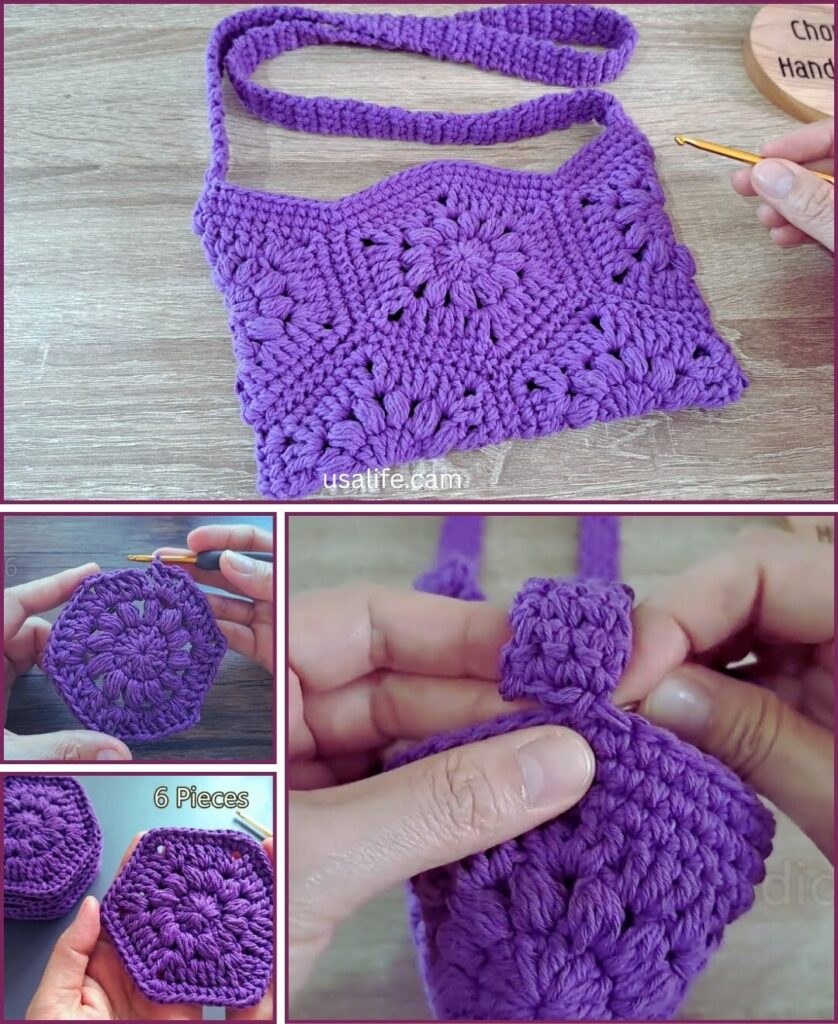
You’ve now got a fantastic, detailed tutorial to create a beautiful and unique granny hexagon bag! Enjoy the process and the compliments you’ll receive on your stunning handmade tote. What colors are you thinking of using?
